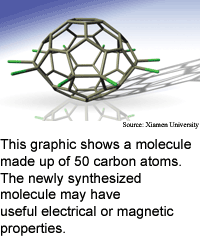
Buckyballs gain smaller kin
Researchers from Xiamen University and
the Chinese Academy of Sciences have constructed a smaller version of
the buckyball or C60 fullerene molecule, a spherical cage of carbon atoms.
The researchers were able to synthesize relatively large quantities
of the smaller fullerene molecules by mixing carbon tetrachloride and
graphite to get C50 molecules. Fullerenes smaller than C60 are predicted
to have unusual electronic and magnetic properties because they're highly
curved, with a shape between a sphere and a disk.
Buckyballs are made from carbon atoms arranged in exactly 12 pentagons
and some number of hexagons, which isolate the pentagons from each other,
allowing molecules to form as spheres. The smaller fullerene molecules
don't satisfy the isolated pentagon rule, but instead contain pentagons
abutting around the periphery of the molecule.
The key to producing the smaller buckyballs was causing chlorine
atoms to attach to the carbon atoms that are shared by abutting pentagons.
The chlorine atoms form a ring around and stabilize the molecular structure.
The new structures, like buckyballs, are related to carbon nanotubes,
which are rolled-up sheets of carbon atoms that have useful electrical,
optical and mechanical properties and show promise in nanotechnology.
The method can also be used to make other smaller fullerenes,
according to the researchers.
It's not yet clear what the new material might be used for, according
to the researchers. The work appeared in the April 30, 2004 issue of Science.
Recognition keys access
Rules aim to get devices talking
Access patterns organize data
Atom-photon link demoed
Briefs:
Plastic nanowires sense gasses
Process nets cheap microstructures
Cursor speed shows virtual bumps
Sensors track martial arts blows
Nanotube moves molten metal
Buckyballs gain smaller kin

Research Watch blog
View from the High Ground Q&A
How It Works
RSS Feeds:
News
Ad links:
Buy an ad link
Ad links: Clear History
Buy an ad link
|
TRN
Newswire and Headline Feeds for Web sites
|
© Copyright Technology Research News, LLC 2000-2010. All rights reserved.